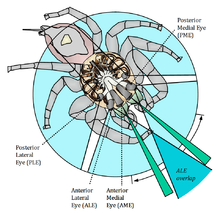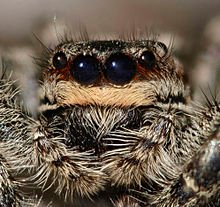The visual fields of a jumping spider
Habitat
Jumping spiders live in a variety of habitats. Tropical forests harbor the most species, but they are also found in temperate forests, scrub lands, deserts, intertidal zones, and mountainous regions. Euophrys omnisuperstes is the species reported to have been collected at the highest elevation, on the slopes of Mount Everest.[8]
Vision
The visual fields of a jumping spider
The eight eyes of a Telamonia dimidiata located near the front
Marpissa muscosa, female
Jumping spiders have four pairs of eyes; three secondary pairs that are fixed and a principal pair that is movable.
The posterior median eyes (PME) are vestigial in many species, but in some primitive sub-families they are comparable in size with the other secondary eyes and help to detect motion.[9] While unable to form images, it is suspected that the reduced pair of eyes has a role similar to that of insect ocelli by receiving light from the sky. The photoreceptors in the other secondary pairs are almost exclusively greensensitive, but the PME have two visual pigments different from that in all the other eyes, sensitive to blue and UV-light.[10]
The posterior lateral eyes (PLE) are wide-angle motion detectors which sense motions from the side and behind. Combined with the other eyes, it gives the spider a near 360-degree view of the world.
The anterior lateral eyes (ALE) have the best visual acuity of the secondary eyes.[11] It has been shown that they are able to distinguish some details as well, and without them no "looming response" will be triggered by motion.[12] Even with all the other pairs covered, jumping spiders in a study could still detect, stalk and attack flies, using the anterior lateral eyes only, which are also sufficiently widely spaced to provide stereoscopic vision.[13]
The anterior median eyes (AME) have very good vision. This pair of eyes is built like a telescopic tube with a corneal lens in the front and a second lens in the back that focus images onto a four-layered retina, a narrow boomerang-shaped strip oriented vertically.[14][15] Physiological experiments have shown they may have up to four different kinds of receptor cells, with different absorption spectra, giving them the possibility of tetrachromatic color vision, with sensitivity extending into the ultraviolet range.[16] As the eyes are too close together to allow depth perception, and the animals do not make use of motion parallax, they have evolved a method called image defocus instead. Of the four photoreceptor layers in the retina, the first two closest to the surface contain ultraviolet-sensitive pigments while the two deepest contain green-sensitive pigments. The incoming green light is only focused on the deepest layer, while the other one receives defocused or fuzzy images. By measuring the amount of defocus from the fuzzy layer, it is possible to calculate the distance to the objects in front of them.[17][18] In addition to receptor cells, also red filters have been detected, located in front of the cells that normally register green light.[19] It seems that all salticids, regardless of whether they have two, three, or four kinds of color receptors, are highly sensitive to UV light.[16] Some species (for example, Cosmophasis umbratica) are highly dimorphic in the UV spectrum, suggesting a role in sexual signaling (Lim & Li, 2005). Color discrimination has been demonstrated in behavioral experiments.
The principal, anterior median, eyes have high resolution (11 min visual angle),[20] but the field of vision is narrow, from 2 to 5°. The central region of the retina, where acuity is highest, is no more than six or seven receptor rows wide. However, the eye can scan objects off the direct axis of vision. As the lens is attached to the carapace, the eye's scanning movements are restricted to its retina through a complicated pattern of translations and rotations.[21] This dynamic adjustment is a means of compensation for the narrowness of the static field of vision. It is analogous to the way most primates move their eyes to focus images of interest onto the fovea centralis. Such movements within the jumping spider's eyes are visible from outside when the attention of the spider is directed to various targets.[22]
